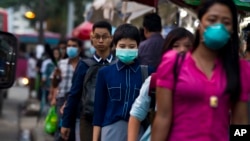The World Health Organization in Myanmar says a recent outbreak of H1N1 in the country is not unusual for the time of the year, and while there may be more cases in the future the available data suggests it is not a cause for panic.
Myanmar’s state media reported on Wednesday that since July 21 there have been 166 confirmed cases and 17 deaths from the virus, known commonly as swine flu after a global pandemic in 2009 was found to have originated in infected pigs. The respiratory infection is now considered a normal human flu.
Seasonal event
Dr. Stephan Paul Jost, WHO’s country representative in Myanmar, said in an interview the consensus based on the evidence so far is that “this is a seasonal event, it’s a seasonal influenza, and there are likely to be also more cases because it is seasonal. And it is not in itself a cause for alarm.”
“Influenza of course can be a serious disease and people can also die from it,” he added. “It happens in every country in the world in the flu season and sometimes even outside it.”
The damp and slightly cooler conditions of Myanmar’s rainy season are also favorable for the influenza virus.
But Jost said the numbers are generally in line with what WHO is seeing in countries in the region.
“It is not in itself an unusual event. Of course we are keeping a close eye on it,” he said.
Monitoring
Dr. Than Htun Aung, the deputy director of the public health department with Myanmar's Ministry of Health and Sports, said the government is in the process of stepping up monitoring and that it’s too early to say whether the virus has tapered off.
“Now we’re controlling. We are waiting [for] more information from the surveillance. We can’t say now,” he said. “I think we can control like other countries did. USA was the same, they had more patients than we had. Now we’re learning what they have done and planning procedures.”
WHO is providing technical support in terms of specific guidelines, consulting with regional experts, and facilitating samples to be sent to laboratories abroad.
It has also worked with Facebook representatives in the region and locally to look at various messaging and discussion about H1N1 on social media, which some believe contributed to an unnecessary panic over the outbreak, with large numbers of people in the commercial capital Yangon donning surgical masks as a main line of defense.
“We’re looking at the different terminology used in Facebook for influenza and for this particular outbreak to see whether we can work together to get more systematic and authoritative messages out that are quite simple but ... recommended by WHO,” Jost said, adding it was an ongoing process. “We are still working together on this to actually find the best way forward.”
A representative for the social media platform in Singapore was not immediately available for comment as August 9 is a public holiday in the country.
Surgical masks
Jost described the use of surgical masks in Myanmar as perhaps a “bit overdone,” in particular N95 masks, which are not recommended for the public as they are difficult to wear and better for hospital environments and health workers.
However, light surgical masks that fit easily on the face can be useful in some situations, he said, especially if you know you have the flu. They may even cut down on transmission in crowded places like buses.
“Influenza is transmitted by a fine droplet. It’s not airborne, you don’t get it just by breathing air. It’s fine droplets, by sneezing and coughing, that are dispersed, that’s transmitted, and that’s usually then also by hand, either by shaking hands or it lands in your hand and you rub your eyes and it enters your system,” he said. “So even masks would not protect from that. You could have a mask and you are rubbing your eyes and you are still getting it.”
“But if you are sick [and wearing a mask] you are preventing then the dispersal of these fine droplets to others. That is definitely helping. That is good,” he added.
One of the other issues that arose in response to the outbreak was a lack of past data that could help authorities assess the scope of the problem.
Jost said WHO had suggested health officials could strengthen the surveillance of cases so “a picture would really emerge that is more consistent, more complete than what is currently available and would give us a better idea historically, what is the historical activity of the influenza viruses in the country.”
He said Myanmar had a lot of cases in 2010, the year after the worldwide outbreak, and also in 2014.
“But how complete this information is we are not as sure as perhaps we could be. And that’s true for many countries,” he said.
Jost also complimented Myanmar's health officials and government partners on the outbreak response, saying it was “very encouraging.”
Aung Naing Soe contributed to this report.







